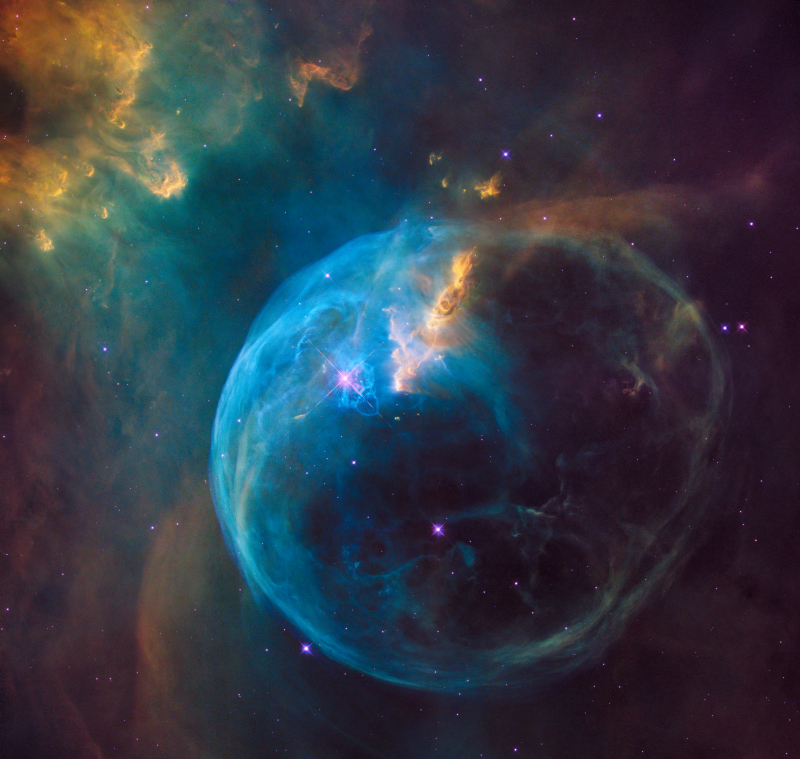Top 10 Things Found in Space
Every year, Earth's satellites discover planets, stars, and other celestial bodies that would be laughed at if they were the creation of a science fiction ... read more...author. Some are perplexing in their structure, others are mind-blowing in their magnitude, and still others are ground-breaking discoveries that minor Earthly issues kept out of the public eye. Here are some Amazing Things Found in Space.
-
Here it is, a much more resemblance to the 2001 Monolith: than any of us would have imagined feasible in A Space Odyssey. A massive square boulder was seen in a photograph taken on December 3, 2021, by the Chinese lunar rover Yutu 2, which was on a mission to explore the South Pole of the "Dark Side of the Moon."
The rover had just discovered a moon stalagmite and other boulders that had fused together. It was initially referred to as the "mystery cottage" by China's National Space Administration. Because it was taken seriously enough, the rover controllers altered the course. We're not talking about a leisurely vacation here. Darwin was especially troubled by this issue since it seemed to go against his beliefs and because some of his detractors were using it to argue for "divine intervention."
In his latter years, Darwin proposed the hypothesis that angiosperms may have originated on an undiscovered island or even a continent, where they may have evolved for millions of years before spreading to other parts of the planet and becoming part of the fossil record that was then known.
Image by Muhammad Haikal Sjukri via unplash.com 
Image by jasper benning via unplash.com -
As far as we know, comets typically aren't that huge. Despite its reputation, Halley's Comet is only 9.3 miles across. Then, in the summer of 2021, a comet that was more impressive than any ice ball before it was discovered. The Bernardinelli-Bernstein Comet has a substantial width of 124 kilometers.
If you're perplexed as to why you weren't aware of the celestial object that dwarfs Halley's, it's in large part because it wasn't yet visible in the night sky. The typical individual won't be able to see it from Earth using consumer-grade technology until 2031. Therefore, if it approaches Earth closer than anticipated (which has already occurred, such as in October 2021 with the asteroid UA21), it may shine in the sky more than ten times brighter than any comet in known history.

Image by Justin Wolff via unplash.com 
Image by Alexander Andrews via unplash.com -
Making enormous swaths of nothingness is what the universe excels at, if anything. TopTenz previously paid homage to the Bootes Void and its 330 million lightyears of emptiness, but we've now learnt that it's a lot smaller than one found in 2005. The length of this supervoid has been calculated to be 1.8 billion lightyears. Not without reason, it has been termed the "supervoid." Yet, since it is three billion lightyears away, you need not worry about ever getting trapped in it.
It has been discovered to be a significant factor in why galaxies on its outer edges are considerably cooler than usual since it is so devoid of stars and other materials to generate heat through a variety of chemical processes. It's also important to keep in mind that nature generally despises empty spaces like the supervoid and the like, with scientists pointing out that stuff is largely spread equally across the rest of the cosmos. Thus it is not a stretch to claim that the supervoid is one of the greatest mysteries in the cosmos.

Image by Casey Horner via unplash.com 
Image by NASA via unplash.com -
As all of our entries to this point have been lightyears distant, it appears that given how extensively we have investigated nearby space, we must look far into space in order to discover anything novel or extraordinary. The South Atlantic Anomaly is an energy shadow that can be found 124 miles from Earth and is so strange that name.
It runs from Zimbabwe to Chile. Satellites orbiting the world are subjected to substantially higher radiation concentrations because the Van Allen Belt, the magnetic and atmospheric force encircling the planet, is closer to Earth for unknown causes.
As a result, satellites are more frequently damaged to the point of radio silence. The enhanced radiation from that perilous journey must simply be accepted by a number of satellites as a fact of life, or possibly a reality of half-life, as there is very little that scientists can do to avoid such a big portion of the sky.

Image by NOAA via unplash.com 
Image by Andy Holmes via unplash.com -
If ancient gold rains aren't your thing, how about supercompressed carbon rains? It turns out that this weather's mechanism is similar to what happened on Gliese 1214B: Methane gas is broken down into carbon clumps by the friction between atmospheric forces that results in lightning. We're not just talking about a lot of insignificant particles either; rather, we're talking about pebbles that can measure up to a centimeter, or about a third of an inch.
According to Dr. Kevin Baines of the University of Madison-Wisconsin and NASA, this process results in the churching of 1,000 tons of diamonds in just the atmosphere of Saturn. It is measured in "tons" relative to Earth, even though the same rocks would obviously weigh far more on Saturn. By no means is this specific to Saturn. The presence of diamonds on Uranus and Neptune was rumored, but Jupiter's chemical makeup appears to make it the only gas giant in the solar system that lacks diamonds. It doesn't mean it has none; it merely breaks them up again very quickly in Jupiter's atmosphere.

Image by Daniel Olah via unplash.com 
Image by Pawel Czerwinski via unplash.com -
No, it's not just a drink deal available at the swankiest clubs in town. Our current abundance of precious metal deposits can be attributed to the bombardment of metal from space. As a heavy metal, gold did not occur very frequently in the natural production of minerals on Earth, which is one of the reasons it is so uncommon. It was up to chemical reactions in stars, particularly neutron stars, to produce gold during the supernova process and send it to planets as meteors, according to an article by Livescience.com from October 2020.
Scientists have sought below the surface of the earth for proof of this rather than up at the stars. Deposits from 70 kilometers were being uncovered in an abnormally high concentration during an excavation at Deseado Massiff, Argentina, in 2017. This indicates that the meteorites that created the Earth's rich gold resources fell in the greatest quantities around 200 million years ago, according to Jose Jimenez of the University of Granada.Don't plan to go prospecting if you learn that Venus has gold rains. That is merely pyrite that has evaporated on the surface and frozen again into crystals in the upper atmosphere like snowflakes. In other words, if you prefer, it's more akin to fools gold rain.

Image by Clem Onojeghuo via unplash.com 
Image by Christopher Campbell via unplash.com -
The presence of water is sometimes used as a sign that a planet may be habitable, but Gliese 1214B differs from Earth in so many other ways that the general laws of water don't seem to apply. It is comparable to K2-141b in that it has an orbit that completes in under 38 hours and has a mass six times that of Earth. Yet because it revolves around a red dwarf star, where the temperature is considerably more tolerable, there is a layer of water on it.
Yet, it is not water as we know it because of the planet's extremely high atmospheric pressure and temperature, which render the water permanently plasmatic and subject to powerful electrical currents. To understand what we're talking about, picture the entire atmosphere being at the same level as a lightning bolt. The superpressure causes crystallization that has been called "hot ice" down on Gliese 1214b's surface. There would actually be water, and there wouldn't be a drop to drink.

Image by Daoudi Aissa via unplash.com 
Image by reza shayestehpour via unplash.com -
Many planets have been mentioned in different lists as being designed to be inhospitable to life. In contrast, K2-141B appears to be intended to be inaccessible. This planet has five times the mass of Earth, and since it orbits its star in just seven Earth hours, the majority of its mass is made up of lava. Its molten oceans are thought to extend 100 kilometers below the surface, thus "most" is not an exaggeration.
While the temperature on the planet's surface is typically around 3,000 degrees Celsius, the third that faces away can suddenly become shockingly chilly when it is briefly out of the sun. It is said to frequently reach -200 degrees Celsius.Large pieces of lava solidify and create ephemeral continents as a result of this temperature shock, along with unimaginably strong winds. They are said to be capable of traveling at 5,000 kilometers per hour, or nearly four times the speed of sound. Any satellite we would attempt to launch there would be covered with metallic frost or vaporized within hours, becoming a regular component of the planet's rocky rain cycle. Also, we're going to hear a lot more about rocky rain in subsequent entries, so be on the lookout for that.

Image by 愚木混株 cdd20 via unplash.com 
Image by 愚木混株 cdd20 via unplash.com -
Binary planets, which revolve around two stars, are well known. It turns out that this is rather typical: Almost 40% of stars are thought to be in binary systems. There is the original Star Wars, which has the recognizable scene with the two suns, if nothing else. But a planet that revolves around three stars? Would something like that be feasible? With so many opposing forces at play, it is impossible for a satellite to stay in orbit. But precisely that is what the GW Orionis System, which is found near the center of the Orion Constellation, does.
The first circumtriple planets were detected in 2018, according to Jeremy Smallwood of the University of Nevada, Las Vegas, 1,300 lightyears away. The fact that the planets in this triptych are gas planets rather than stony ones, which you'd expect would be more susceptible to being destroyed by conflicting forces, is particularly surprising. The gaseous spheres are kept intact and revolving on their merry, unusually complex course by an abundance of solar winds in the GW Orionis system, which is nearly two and a half times the size of Pluto's orbit around the Sun.

Image by NASA via unplash.com 
Image by NASA via unpalsh.com -
Pareidolia is a mental habit that causes people to detect patterns in seemingly random configurations; typically, it causes them to imagine faces. This June 2019 image, provided by none other than the Hubble Telescope, wouldn't require particularly sophisticated vision to reveal a truly alien face. That makes me think of a picture that might appear at the conclusion of a new Men in Black movie to demonstrate how an alien being's presence is woven throughout the cosmos.
Even if we are unsure if there is a creature that uncannily coincidentally resembles this visage, the fact itself is rather astounding. Despite being around 700 lightyears away from Earth, this is the collision of two galaxies, especially the Arp-Madore 2026-424 System, and it has been known about it since 1987. New stars that are being traded during the collision are what give the "face" its blue outline. As we've seen in past lists, the estimated duration of such a merger of galaxies is 100 million years, which is extremely brief in cosmic terms.

Image by ANIRUDH via unplash.com 
Image by Javier Miranda via unplash.com































